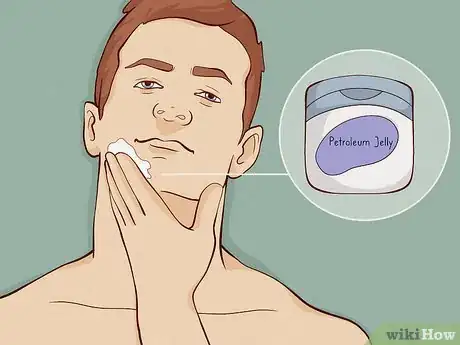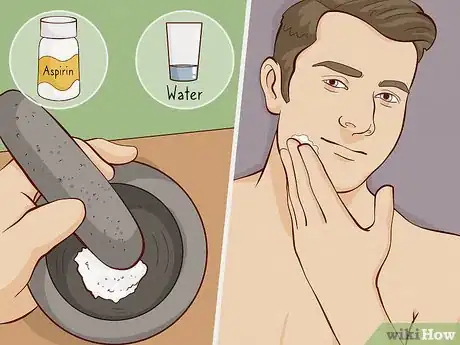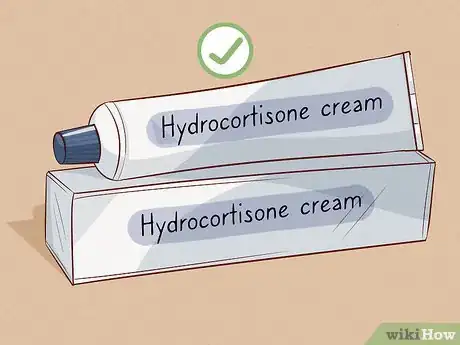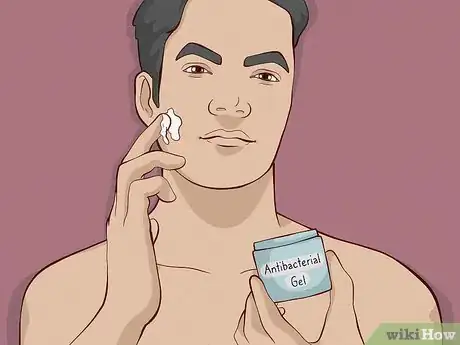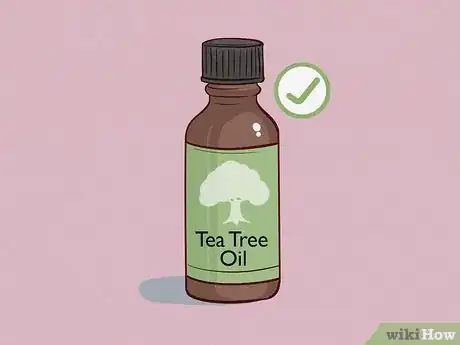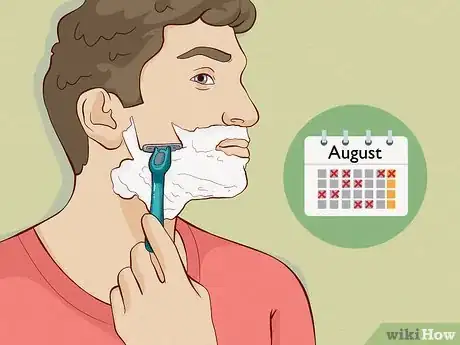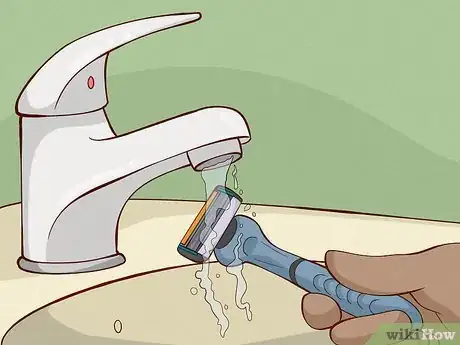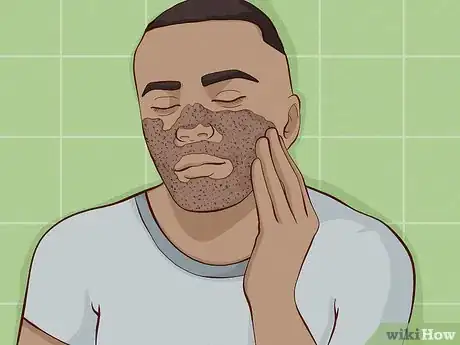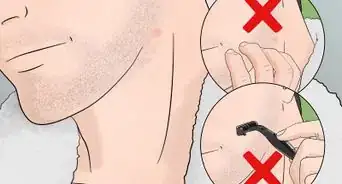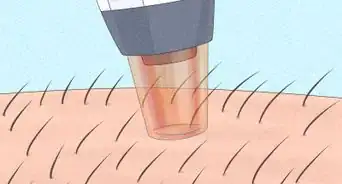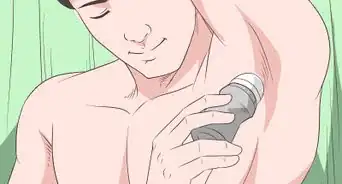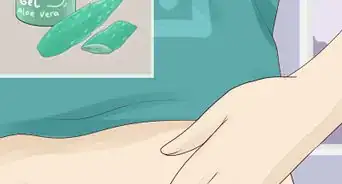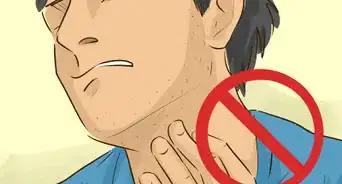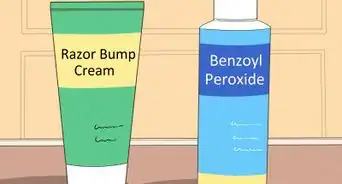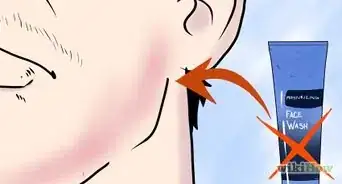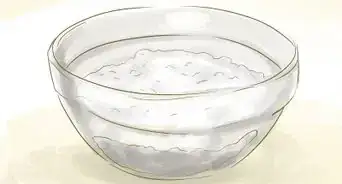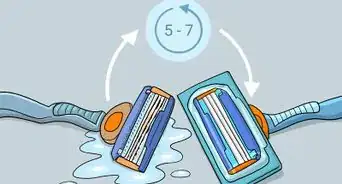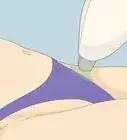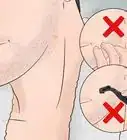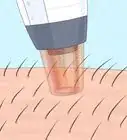This article was medically reviewed by Sarah Gehrke, RN, MS. Sarah Gehrke is a Registered Nurse and Licensed Massage Therapist in Texas. Sarah has over 10 years of experience teaching and practicing phlebotomy and intravenous (IV) therapy using physical, psychological, and emotional support. She received her Massage Therapist License from the Amarillo Massage Therapy Institute in 2008 and a M.S. in Nursing from the University of Phoenix in 2013.
There are 8 references cited in this article, which can be found at the bottom of the page.
This article has been viewed 81,944 times.
Shaving rash, also known as razor burn, can be an annoying and painful experience. The likelihood of a shaving rash depends on many things, including skin type, routine, method, and razor. Fortunately, if you notice signs of rash, there are a number of steps you can take to soothe your skin and get rid of your razor burn. Deal with shaving rash with medications, natural remedies, by improving your shaving routine.[1] [2]
Steps
Treating Shaving Rash Immediately
-
1Apply a cold compress. Wrap an ice pack or ice cubes in a clean cloth and place them on the affected area as soon as you notice a rash developing. The cold temperature will reduce immediate swelling and redness, and might help reduce discomfort. Avoid rubbing the cloth along your skin. Instead, gently pat your irritated skin if the surface area is larger than your cold compress.[3]
- You can also make a cold compress by soaking a towel in very cold water, or putting a wet towel in the freezer for 10 to 15 minutes (before it has time to freeze solid).
-
2Use petroleum jelly for instant relief. To soothe the first signs of discomfort, irritation, and pain due to shaving rash, apply a thin coat of petroleum jelly. It will keep your skin hydrated, preventing further irritation, and relieve itchiness. Apply a coat to protect your skin, and repeat after a few hours or if the area has started to dry out.[4]Advertisement
-
3Make an aspirin paste. Try easing immediate discomfort and inflammation by crushing a couple aspirin in a few drops of water, and mixing it well to make a paste. Apply the paste to the irritated area for up to 10 minutes, then rinse with lukewarm water. Repeat regularly up to three times a day if you continue to experience symptoms.[5]
- If you have dry or sensitive skin, leave the paste on for a shorter period of time to avoid irritation.
- Avoid using aspirin on your skin if you're allergic to it or any of its ingredients or experience problems with bleeding, such as the inability to form blood clots. Consult your doctor if you have any questions about any sensitivities to aspirin.
-
4Treat itching or pain with hydrocortisone cream. You can purchase hydrocortisone from any convenience or grocery store. Dab a small amount onto your fingertip or cotton swab, and gently spread it onto the affected area so your skin absorbs it. Use it according to directions on its package, and avoid applying it to open wounds.
-
5Prevent infection and further irritation. Apply an antibacterial or antiseptic agent, like an antibacterial gel or an alternative such as witch hazel. Use the product according to its instructions to cut down on bacteria and help heal the rash more quickly. If no other antibacterial products are available, consider dabbing the area with a cotton ball dipped in alcohol.
- While rubbing alcohol and alcohol-based products will kill germs, they will also dry out your skin and may cause stinging upon application. Using them too frequently can result in overdrying, so use sparingly.
- Check the labels of the skin products you use to see if they contain alcohol.
- If your cleanser or antibacterial agent contains alcohol and irritates your skin, either stop using it or use it in conjunction with a balm or petroleum jelly.
Using Natural Remedies
-
1Apply Aloe Vera pulp, gel, or spray to soothe shaving rash. While aloe vera gels and sprays are available, using the pulp directly from a leaf offers the best results. Dab it onto the affected area and let sit for a half hour or more, then rinse with cool water. Repeat if necessary or desired.[6]
- If you go with a store bought product, check its label for alcohol. Avoid using alcohol-based products as they will dry out your skin, causing further irritation.
-
2Try tea tree oil. Consider using tea tree oil either on its own or blended with a skin product. Apply enough oil to saturate the the area you shaved immediately after hair removal. You can also add several drops of tea tree oil to the moisturizer or balm you use after shaving. [7]
- Some people are sensitive to tea tree oil, so you might want to dilute it before applying. Mix a half teaspoon of it with three tablespoons of olive oil. Diluting with essential oils is not recommended.[8]
-
3Hydrate and soothe skin with coconut oil. Rub a small amount of coconut oil onto your irritated skin. If you're not planning on rinsing, use an amount small enough for your skin to absorb. Alternatively, you can apply a thin coating, leave it on for about a half hour, then rinse with lukewarm water.[9]
- If you leave coconut oil on your skin, be careful about coming into contact with clothes or furniture fabric, since it can leave tough to remove stains.[10]
-
4Use honey to soothe skin irritated by shaving rash. Apply directly to your skin and let it sit for about ten minutes. Rinse it off with lukewarm water, then finish with cool water. Honey reduces inflammation, reduces itchiness, and nourishes your skin.[11]
- Add an equal part of oatmeal for gentle exfoliation. Do not exfoliate broken skin, as this can further irritate razor burn.
- Consider mixing equal parts honey and yogurt to soothe skin. Apply the mixture, leave it on for about ten minutes, and rinse off first with lukewarm then with cool water.
Improving Your Hair Removal Technique
-
1Give your skin a day off. Avoid shaving every day or every other day, and try to work in a skip day in which you don't shave on a day you would normally. Your skin needs a couple days to recover from the shaving process. Whether it's removing facial or body hair that causes your skin irritation, give your skin a break when possible and use moisturizing and exfoliating products in between shaves.[12]
- Do your best not to shave skin that's already irritated: more shaving will make razor burn worse.[13]
- If you are required to be clean shaven or your hair grows too fast for you to comfortably go without shaving for more than a day, consider using an electric razor, which is easier on your skin. Make sure any electric razor has new, well-oiled blades for the least irritation. [14]
-
2Practice hygienic, skin-friendly shaving techniques. Shaving during or after a shower is preferable, but if you're not showering, wash your skin with warm water and a mild cleanser before shaving. Use a clean, sharp razor and a shaving cream or gel to lubricate your skin. Try not to shave using only a razor, soap, and water.[15]
- Don't overuse dull razors, and wash your razor with soap and hot water after using it. Change blades or throw away disposable razors after 5 to 7 shaves to help minimize irritation.
- Shave in the direction that the hair grows, whether you're removing facial or body hair.
- Rinse your razor out with warm water every few strokes. This will help keep hair from becoming caught between the blades, keeping it sharper and cleaner.
- After shaving, use a moisturizing lotion or balm, and if you've removed body hair, wear loose fitting clothing made of a natural fiber, like cotton.
-
3Adopt an exfoliating and moisturizing skin care routine. Consider using a cleansing product that will exfoliate your skin, or provide gentle abrasion to remove surface dirt and buildup. You can easily exfoliate using baking soda by adding it to your face wash or shaving cream, or rubbing your skin with it before shaving.[16]
- Exfoliating before shaving will raise individual hairs from your skin, making shaving easier and preventing future irritation or ingrown hairs.[17]
- An after-shave moisturizing lotion or balm will help soothe your skin, and using an oil-free daily moisturizer will help it recover from the shaving process.[18]
-
4Consult a doctor if your rash is severe or accompanies other skin problems. If you routinely suffer from shaving rash and it doesn't respond to home treatments, consider seeing your doctor or dermatologist. They can assess your symptoms, and if necessary, offer antibiotic, retinoid, or cortisone medications available only by prescription.[19]
References
- ↑ https://www.aad.org/public/skin-hair-nails/skin-care/how-to-shave
- ↑ https://www.ncbi.nlm.nih.gov/pubmed/22385029
- ↑ http://www.nlda.org/a/how-to-get-rid-of-razor-burn/
- ↑ http://www.nlda.org/a/how-to-get-rid-of-razor-burn/
- ↑ http://www.nlda.org/a/how-to-get-rid-of-razor-burn/
- ↑ https://www.ncbi.nlm.nih.gov/pmc/articles/PMC2763764/
- ↑ http://naturalremedyideas.com/get-rid-of-razor-bumps/
- ↑ http://www.nlda.org/a/how-to-get-rid-of-razor-burn/
- ↑ http://naturalremedyideas.com/get-rid-of-razor-bumps/
- ↑ http://www.nlda.org/a/how-to-get-rid-of-razor-burn/
- ↑ http://www.nlda.org/a/how-to-get-rid-of-razor-burn/
- ↑ http://www.mayoclinic.org/diseases-conditions/folliculitis/basics/prevention/con-20025909
- ↑ https://www.ncbi.nlm.nih.gov/pubmed/23652888
- ↑ http://www.nlda.org/a/how-to-get-rid-of-razor-burn/
- ↑ http://www.mayoclinic.org/diseases-conditions/folliculitis/basics/prevention/con-20025909
- ↑ http://www.nlda.org/a/how-to-get-rid-of-razor-burn/
- ↑ https://www.aad.org/media/news-releases/evaluate-before-you-exfoliate
- ↑ https://www.ncbi.nlm.nih.gov/pubmed/22385029
- ↑ http://www.mayoclinic.org/diseases-conditions/folliculitis/basics/prevention/con-20025909
About This Article
To get rid of a shaving rash, start by applying a cold compress as soon as you notice a rash developing, which will reduce the swelling and redness. Then, apply aloe vera gel to the area to soothe your skin and let it sit for 30 minutes before rinsing it off. Alternatively, apply honey to the rash for 10 minutes to reduce inflammation and nourish your skin, then rinse it off so it doesn’t make a mess. You can also rub a small amount of coconut oil onto the irritated skin to moisturize and soothe the rash. For tips from our Medical reviewer on how to avoid getting a shaving rash next time, read on!

